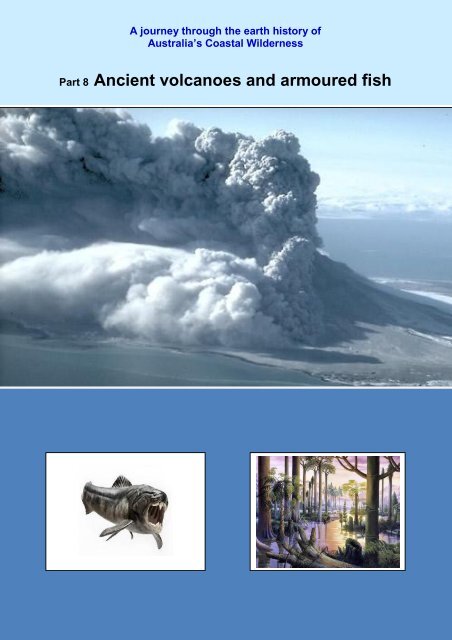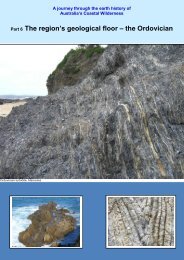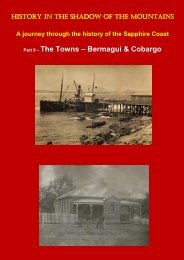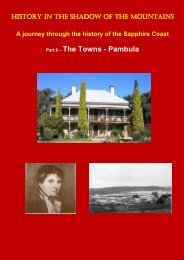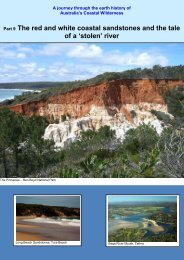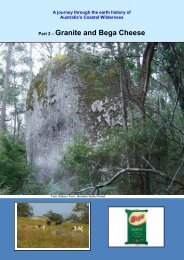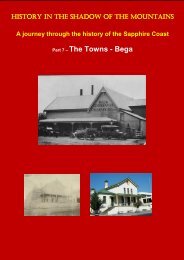8 Ancient volcanoes and armoured fish - Sapphire Coast
8 Ancient volcanoes and armoured fish - Sapphire Coast
8 Ancient volcanoes and armoured fish - Sapphire Coast
- No tags were found...
You also want an ePaper? Increase the reach of your titles
YUMPU automatically turns print PDFs into web optimized ePapers that Google loves.
A journey through the earth history ofAustralia’s <strong>Coast</strong>al WildernessPart 8 <strong>Ancient</strong> <strong>volcanoes</strong> <strong>and</strong> <strong>armoured</strong> <strong>fish</strong>
8. The Eden-Comerong-Yalwal Volcanic RiftThe Devonian – Australia’s Yellowstone 380 to 360 million years agoBy Middle <strong>and</strong> Late Devonian time, south eastern Australia was a l<strong>and</strong> mass with amoderate relief <strong>and</strong> possible shallow seas or large lake systems to the east. Thel<strong>and</strong> mass formed part of the pre-Gondwanan supercontinent Pangea. Thecontinental crust of Pangea began to stretch <strong>and</strong> thin to form a narrow rift inresponse to changes in the motions of the tectonic plate margin to the east.The Eden-Comerong-Yalwal rift zone is the name given to the long narrow zone thatpreserves the deposits accompanying this event. This name describes the knownextent of the rocks in the rift from Eden in the south to Yalwal, west of Nowra, in thenorth. The northernmost extent of the zone is unknown as it is covered by youngerrocks of the Sydney Basin.Although narrow, the rift basin was similar to modern rift basins such as those
forming today in the East African Rift. Volcanic activity began, as hot rock explodedthrough the thinned crust. The main areas of subaerial volcanism were along theeastern part of the Eden region. Thick ignimbrite sheets covered the l<strong>and</strong>scape.Parts of the area were like the active volcanic region of Yellowstone in northwesternUnited States.Ignimbrite: An ignimbrite is the deposit of a pyroclastic density current, orpyroclastic flow, a hot suspension of particles <strong>and</strong> gases that flows rapidly from avolcano, driven by a greater density than the surrounding atmosphere.Ignimbrites are made of a mixture of volcanic ash <strong>and</strong> pumice fragments. The ashis composed of glass shards <strong>and</strong> crystal fragments. Ignimbrites may be loose <strong>and</strong>unconsolidated, or lithified (solidified) rock called lapilli-tuff. The term 'ignimbrite'means ‘fiery rock dust cloud’, from the Latin igni- (fire) <strong>and</strong> imbri- (rain), formed asthe result of immense explosions of pyroclastic ash, lapilli <strong>and</strong> blocks flowing downthe sides of <strong>volcanoes</strong> (modified from Wikipedia).Some ignimbrite sheets contain beds of broken rock <strong>and</strong> sediment. Two smallgranite plutons were intruded into shallow crustal levels during the volcanism: redGabo Isl<strong>and</strong> Granite <strong>and</strong> the Mumbulla Granite, seen today as Mumbulla Mountainjust north east of Bega.
The volcanic activity was short lived (5-10 million years). It however produced asuite of rocks <strong>and</strong> l<strong>and</strong>scape that is a distinctive feature of the region.<strong>Coast</strong>al exposures around Eden, Tathra <strong>and</strong> Mimosa Rocks show what thevolcanism was like.EdenAt Eden, the shoreline around the wharf area at Snug Cove <strong>and</strong> the lookout on theheadl<strong>and</strong> in the heart of Eden are places to see volcanic features. The headl<strong>and</strong> –Middle Head - gives Twofold Bay its name, jutting proudly out into the great bay,separating it into its two ‘folds’.Middle Head at Eden, Balawan (Mt Imlay) in the backgroundGoogle EarthThe headl<strong>and</strong> is made of hard, erosion-resistant volcanic rock.Across from the lookout st<strong>and</strong>s the white pole of the ‘lighthouse’ leading the way toSnug Cove. Below the lighthouse, the massive cliff is formed from ignimbrite.
As viewed from the lookout the cliff is a cross section through a couple of separateignimbrite flows. Now tilted towards the open ocean, the flows would have originallybeen laid down almost flat. The almost vertical structures in the cliff are fracturesseparating hexagonal columns formed during cooling of flows that poured out over anancient l<strong>and</strong> surface about 360 Mya. The flows were not liquid lava flows, but cloudsof sticky ash particles, so charged with gases that they flowed like water.These glowing ash clouds flowed over the l<strong>and</strong>scape, gradually losing gas <strong>and</strong>cooling until they became the consistency of toothpaste. Bubbles of gas became‘frozen’ in this sticky rock as it finally set solid. Some fossil bubbles, now filled withsoft greenish clay minerals, can be seen embedded in the solid rock at the back ofCobbly Beach, on the western side of Snug Cove, in the Port of Eden.Pyroclastic flow from Mt Pinatubu, PhilippinesEruption centres were surrounded by fumaroles emitting hot water <strong>and</strong> steam, similarto today’s volcanic fields such as Yellowstone in north western United States, orRotorua in Aotearoa – New Zeal<strong>and</strong>. This hydrothermal activity altered some partsof the volcanic rock inl<strong>and</strong> from Pambula to a soft, easy to carve clay-like mineral,pyrophyllite.Mimosa RocksIn Mimosa Rocks National Park north of Tathra, volcanic eruptions occurred on thefloor of a deep lake. The results can be seen in the cliffs at the northern end ofAragunnu Beach.Here there is an extraordinary array of various kinds of volcanic materials mixed withblack mudstone. The story revealed in this complexity is that of a deep freshwaterlake floored by black muds. Fishes swam in its waters, <strong>and</strong> an occasional lycopod (afossil plant like a modern tree fern) floated in <strong>and</strong> sank to the bottom. Flattenedremains of lycopod (club mosses) trunks can be seen in the black mudrocks at PicnicPoint, south of Aragunnu. These indicate one of the earliest Gondwanan forestenvironments, pictured below.Club mosses are common around the world today but are only present in a groundhugging moss-type form, a far cry from these, the world’s first forests.
The Bunga beds near Picnic Point also contain some of the earliest known examplesof fossilised shark remains.Into the Aragannu quiet lake environment rose a bulging volcanic dome whicheventually burst through the lake floor <strong>and</strong> began to erupt – underwater. The lakewater boiled <strong>and</strong> fumed, shattering bedrock into a mosaic of interlocking pieces. Theerupting lava also broke up, forming a mass of fragments. As the dome grew, largechunks of lava were shed down its sides. The result? Geological chaos.The mass of fragments is frozen into the rocks next to the Mimosa Rocks.Ignimbrite similar to that forming Middle Head at Eden is also well-exposed on thecoast at Mimosa Rocks. The following overlays the turbidites (now tilted on its side)that formed in the aquatic setting.
Cooling columns of ignimbrite form the next headl<strong>and</strong> north of Aragunnu.North headl<strong>and</strong> Rocky Beach – Aragannu, Mimosa Rocks National ParkWave attack has detached many columns, which have broken up into the bouldersnow forming the beach.Broken columns, Rocky Beach – Aragannu, Mimosa Rocks National ParkGoogle Earth
TathraTathra Headl<strong>and</strong> <strong>and</strong> the rugged rock coast southwards to Bournda Isl<strong>and</strong> iscomposed of Devonian volcanics.Heritage listed Tathra wharf <strong>and</strong> headl<strong>and</strong>The rocks are so shattered by folding <strong>and</strong> faulting that any original structure isdifficult to see. Around the boat ramp area at Kianinny Bay, <strong>and</strong> near the remains ofthe old road around Tathra Headl<strong>and</strong>, can be seen fine-scale layering that may belayers of ash. On the northern headl<strong>and</strong> overlooking the boat ramp, it’s possible tosee a layer of rounded cobbles within the volcanics if you walk towards the open sea.Kianinny Bay, TathraWhen volcanic activity died away, the Wilderness <strong>Coast</strong> region returned to a stablel<strong>and</strong>mass with moderate relief inl<strong>and</strong>, with coastal or lake conditions in the east. Achange in climate initiated large river systems across the l<strong>and</strong>mass. Following aninitial phase of river deposition, typified by conglomerate, pebble s<strong>and</strong>stone, purplecoarse s<strong>and</strong>stone <strong>and</strong> red mudstone, there was a rise in sea level. Shallower areaswere inundated <strong>and</strong> fine sediments typical of shallow marine to lagoonal conditionswere deposited. A slight sea level fall allowed the rivers to extend across l<strong>and</strong> again,burying the lagoonal muds.The Devonian – the Age of Fishes (360 million years ago)Not for nothing is the Devonian known as the Age of Fishes. Dozens of species ofenormous <strong>armoured</strong> <strong>fish</strong>es evolved to live, breed <strong>and</strong> die in Devonian rivers <strong>and</strong>seas.L<strong>and</strong> masses around the world were criss-crossed by giant rivers carrying s<strong>and</strong> <strong>and</strong>mud left behind extensive deposits of pink s<strong>and</strong>stone, representing former s<strong>and</strong>yriver channels, <strong>and</strong> red floodplain mudstone. The rivers were ideal habitats forevolving <strong>fish</strong>es.
The coastline of the <strong>Sapphire</strong> <strong>Coast</strong> between Tura Beach <strong>and</strong> the Victorian border iscomposed largely of these red, riverine rocks. Here <strong>and</strong> there on rock platforms thescattered remains of the platy armour of these <strong>fish</strong>es can be seen. Rarely, entirecorpses of these <strong>fish</strong>es are preserved where they died, trapped in drying billabongs<strong>and</strong> rapidly buried by sediment carried by the next flood. Casts of some of these<strong>fish</strong>es are on display at the Eden Killer Whale Museum.WikipediaANUNot only is our coastline a happy hunting ground for fossil <strong>fish</strong> researchers, but it hasyielded species new to science, making it a world-class fossil <strong>fish</strong> site.A new species of fossil <strong>fish</strong> from Eden has been named Edenopteron.The reddened rocks mark a great leap upwards in atmospheric oxygen as l<strong>and</strong> plantsbegan to cover large parts of Earth. Roots of plants that grew on river floodplainscan be seen in the red mudstones behind the building at Merimbula Wharf. Theoxygen-rich atmosphere encouraged the development of lungs instead of gills, <strong>and</strong>gave rise to the first amphibians <strong>and</strong> l<strong>and</strong>-dwelling reptiles. The oldest tetrapod (fourfooted animal - ) trackway in the world is found in Devonian rocks just across theNSW-Victoria border.Museum of Victoria


